If your web-browser homepage has modified to the Weather Forecast Alerts, then your web-browser has become the victim of hijacker. It means that an unwanted program has taken over and changed settings of installed web browsers, without your desire or permission. So, if the Firefox, Google Chrome, IE and Microsoft Edge startpage, newtab and search provider by default has been modified or your web-browser being redirected to the web-page you never intended to visit, then it is a sign that you need to clean up your system ASAP in order to remove Weather Forecast Alerts annoying start page.
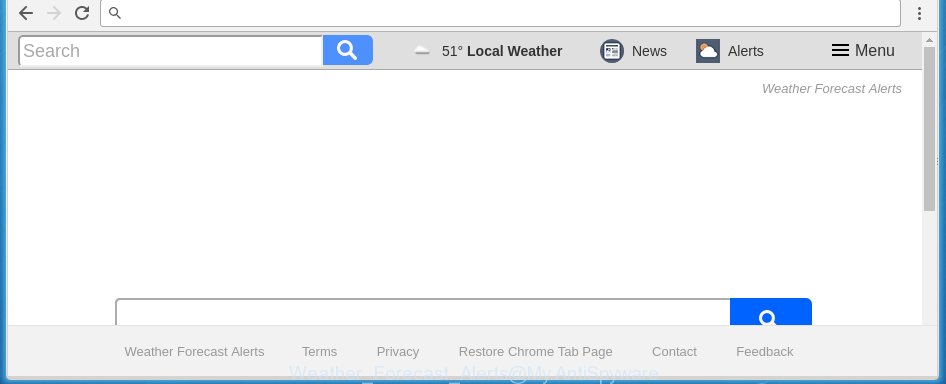
Besides the fact that Weather Forecast Alerts browser hijacker replaces your home page, this annoying web-site can set yourself as your search engine. But, obviously, it does not give you a good search results, as they will consist of tons of advertisements, links to unwanted and ad web pages and only the remaining part is search results for your query from the major search engines. Of course, the very fact that you encounter with the inability to properly search the Net, is an unpleasant moment. Moreover, the Weather Forecast Alerts browser hijacker infection may collect information about you, and in the future to transfer it to third parties. What creates the risk of theft of your personal data.
Table of contents
- What is Weather Forecast Alerts
- How to delete Weather Forecast Alerts
- Manual Weather Forecast Alerts start page removal
- Delete Weather Forecast Alerts associated software by using MS Windows Control Panel
- Disinfect the browser’s shortcuts to get rid of Weather Forecast Alerts
- Remove Weather Forecast Alerts redirect from Internet Explorer
- Remove Weather Forecast Alerts from FF
- Get rid of Weather Forecast Alerts start page from Chrome
- How to automatically remove Weather Forecast Alerts hijacker
- Manual Weather Forecast Alerts start page removal
- How to stop Weather Forecast Alerts
- How does your system get infected with Weather Forecast Alerts browser hijacker
- Finish words
The Weather Forecast Alerts hijacker is not a virus, but the virus behaves similarly. As a rootkit hides in the system, changes settings of web browsers, and blocks them from changing. Also this hijacker infection can install additional browser addons, extensions and modules that will show ads and popups. And finally, the Weather Forecast Alerts hijacker can collect personal info like what web-pages you are opening, what you are looking for the Internet and so on. This information, in the future, can be sold to third parties.
Thus, it is clear that the presence of browser hijacker on your computer is not desirable, and you need to clean up your computer ASAP. Follow the few simple steps below in order to remove Weather Forecast Alerts unwanted .
How to delete Weather Forecast Alerts
The answer is right here on this page. We have put together simplicity and efficiency. It will help you easily to free your computer of browser hijacker. Moreover, you can choose manual or automatic removal method. If you are familiar with the system then use manual removal, otherwise run the free anti-malware utility created specifically to delete browser hijacker like Weather Forecast Alerts. Of course, you can combine both methods. Read this manual carefully, bookmark or print it, because you may need to close your internet browser or reboot your PC.
Manual Weather Forecast Alerts removal
Most common browser hijackers may be uninstalled without any antivirus programs. The manual hijacker infection removal is post guide that will teach you how to remove the Weather Forecast Alerts . Some of the steps below will require you to close the web-page. So, please read the steps carefully, after that bookmark or print it for later reference.
Delete Weather Forecast Alerts associated software by using MS Windows Control Panel
We recommend that you begin the machine cleaning procedure by checking the list of installed programs and uninstall all unknown or suspicious applications. This is a very important step, as mentioned above, very often the harmful software such as ‘ad supported’ software and browser hijackers may be bundled with free programs. Uninstall the unwanted software can remove the unwanted advertisements or web-browser redirect.
Press Windows button ![]() , then click Search
, then click Search ![]() . Type “Control panel”and press Enter. If you using Windows XP or Windows 7, then click “Start” and select “Control Panel”. It will show the Windows Control Panel like below.
. Type “Control panel”and press Enter. If you using Windows XP or Windows 7, then click “Start” and select “Control Panel”. It will show the Windows Control Panel like below.

Further, press “Uninstall a program” ![]()
It will display a list of all software installed on your PC. Scroll through the all list, and uninstall any suspicious and unknown software.
Disinfect the browser’s shortcuts to get rid of Weather Forecast Alerts
When installed, this hijacker infection may add an argument like “http://site.address” into the Target property of the desktop shortcut for the Chrome, Internet Explorer, FF and Microsoft Edge. Due to this, every time you start the internet browser, it will open the annoying start page.
Right click to a desktop shortcut for your internet browser. Choose the “Properties” option. It will open the Properties window. Select the “Shortcut” tab here, after that, look at the “Target” field. The browser hijacker infection can modify it. If you are seeing something similar “…exe http://site.address” then you need to remove “http…” and leave only, depending on the web browser you are using:
- Google Chrome: chrome.exe
- Opera: opera.exe
- Firefox: firefox.exe
- Internet Explorer: iexplore.exe
Look at the example as on the image below.

Once is finished, press the “OK” button to save the changes. Please repeat this step for web-browser shortcuts which redirects to an unwanted web pages. When you have completed, go to next step.
Remove Weather Forecast Alerts redirect from Internet Explorer
To restore the startpage, new tab page and search engine by default you need to reset the IE to the state, which was when the MS Windows was installed on your PC.
First, start the Internet Explorer, click ![]() ) button. Next, press “Internet Options” as shown below.
) button. Next, press “Internet Options” as shown below.

In the “Internet Options” screen select the Advanced tab. Next, press Reset button. The Microsoft Internet Explorer will display the Reset Internet Explorer settings prompt. Select the “Delete personal settings” check box and click Reset button.

You will now need to restart your system for the changes to take effect. It will get rid of Weather Forecast Alerts hijacker, disable malicious and ad-supported web-browser’s extensions and restore the Internet Explorer’s settings such as home page, new tab page and search engine by default to default state.
Remove Weather Forecast Alerts from FF
Click the Menu button (looks like three horizontal lines), and click the blue Help icon located at the bottom of the drop down menu as shown on the image below.

A small menu will appear, click the “Troubleshooting Information”. On this page, click “Refresh Firefox” button as shown in the figure below.

Follow the onscreen procedure to return your FF internet browser settings to its original state.
Get rid of Weather Forecast Alerts homepage from Chrome
Reset Google Chrome settings is a simple way to get rid of the browser hijacker, malicious and ‘ad-supported’ extensions, as well as to restore the internet browser’s start page, new tab and search engine by default that have been changed by Weather Forecast Alerts browser hijacker.

- First, start the Chrome and press the Menu icon (icon in the form of three horizontal stripes).
- It will open the Chrome main menu, click the “Settings” menu.
- Next, click “Show advanced settings” link, that located at the bottom of the Settings page.
- On the bottom of the “Advanced settings” page, click the “Reset settings” button.
- The Google Chrome will display the reset settings prompt as on the image above.
- Confirm the internet browser’s reset by clicking on the “Reset” button.
- To learn more, read the blog post How to reset Chrome settings to default.
How to automatically remove Weather Forecast Alerts hijacker
Many antivirus companies have designed programs that help detect and remove browser hijacker, and thereby restore installed web browsers settings. Below is a a few of the free programs you may want to use. You PC can have a large amount of PUPs, ad-supported software and browser hijackers installed at the same time, so we recommend, if any unwanted or malicious program returns after rebooting the machine, then boot your computer into Safe Mode and use the anti malware utility once again.
Run Malwarebytes to get rid of browser hijacker
We recommend using the Malwarebytes Free. You can download and install Malwarebytes to detect and delete Weather Forecast Alerts from your computer. When installed and updated, the free malware remover will automatically scan and detect all threats present on the computer.
Download Malwarebytes from the link below.
327077 downloads
Author: Malwarebytes
Category: Security tools
Update: April 15, 2020
Once downloaded, close all applications and windows on your machine. Open a directory in which you saved it. Double-click on the icon that’s named mbam-setup as shown on the screen below.
![]()
When the setup starts, you will see the “Setup wizard” that will help you install Malwarebytes on your PC system.
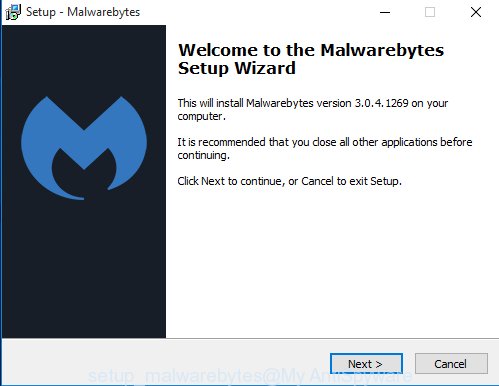
Once installation is done, you will see window as shown on the screen below.
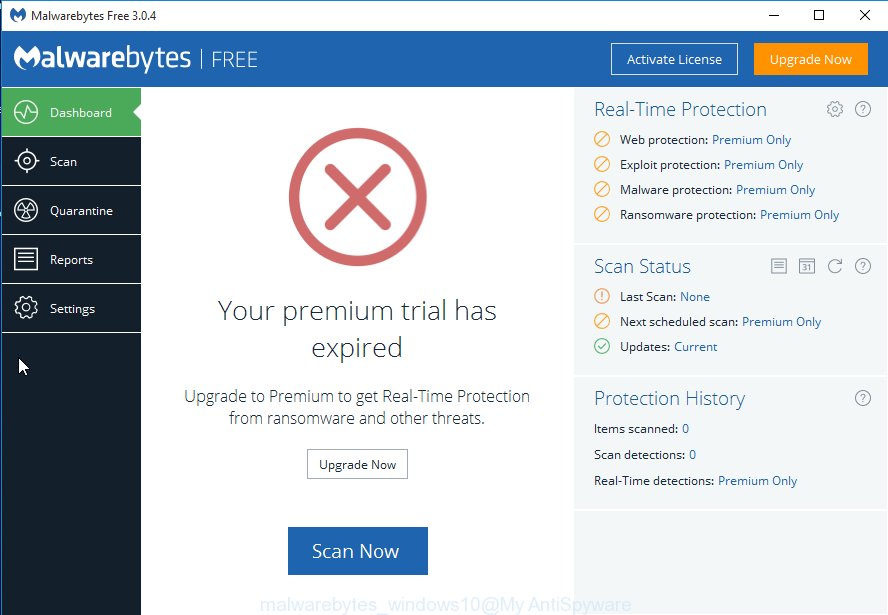
Now click the “Scan Now” button . This will begin scanning the whole computer to find out hijacker that cause a redirect to Weather Forecast Alerts. This procedure may take some time, so please be patient. While the program is scanning, you can see how many objects it has identified as threat.
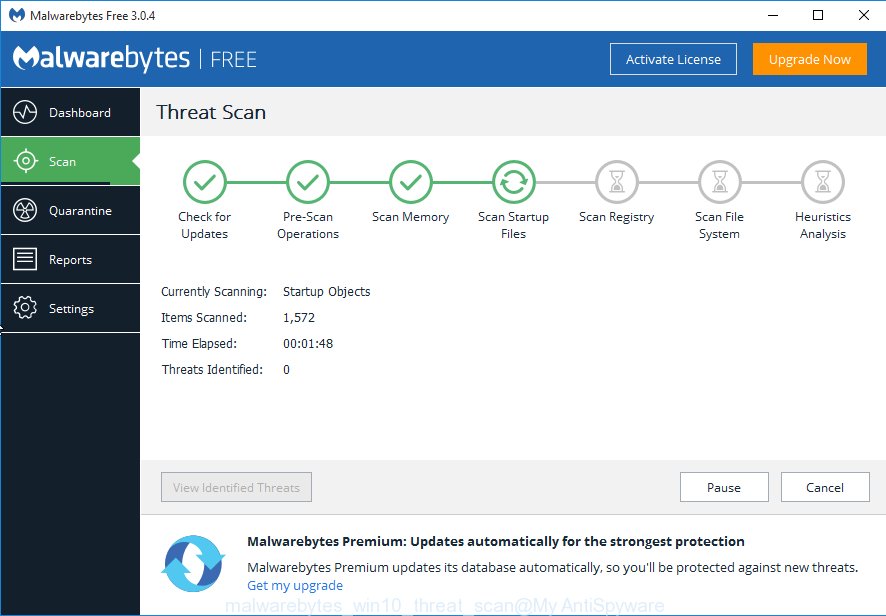
When the scan is finished, you may check all items found on your machine. Next, you need to click “Quarantine Selected” button.
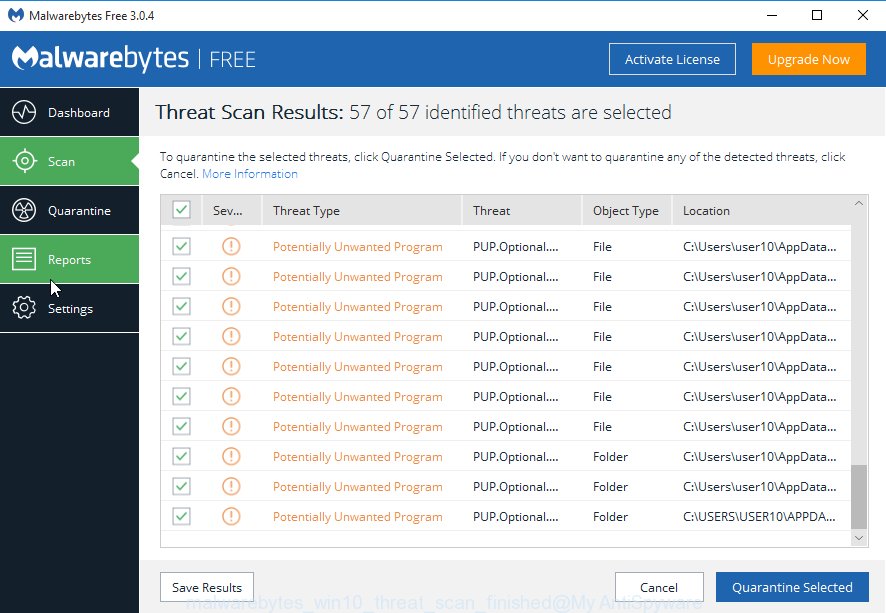
The Malwarebytes will start removing Weather Forecast Alerts hijacker related files, folders, registry keys. Once disinfection is finished, you may be prompted to reboot your PC system.
The following video explains tutorial on how to remove browser hijacker with Malwarebytes Anti-malware.
Remove Weather Forecast Alerts browser hijacker and malicious extensions with AdwCleaner
This removal application is free and easy to use. It can scan and remove browser hijacker like Weather Forecast Alerts, malicious software, PUPs and adware in Chrome, Firefox, Microsoft Internet Explorer and Microsoft Edge web-browsers and thereby revert back their default settings (startpage, newtab and default search engine). AdwCleaner is powerful enough to find and remove malicious registry entries and files that are hidden on the PC.
Download AdwCleaner by clicking on the link below.
225547 downloads
Version: 8.4.1
Author: Xplode, MalwareBytes
Category: Security tools
Update: October 5, 2024
After the download is complete, open the file location. You will see an icon like below.
![]()
Double click the AdwCleaner desktop icon. When the utility is started, you will see a screen as on the image below.
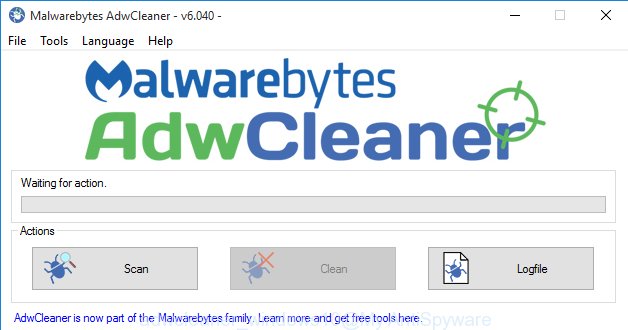
Further, click “Scan” button to perform a system scan for the Weather Forecast Alerts hijacker which cause a redirect to Weather Forecast Alerts. Once the scanning is finished, you’ll be displayed the list of all found threats on your computer as shown on the screen below.
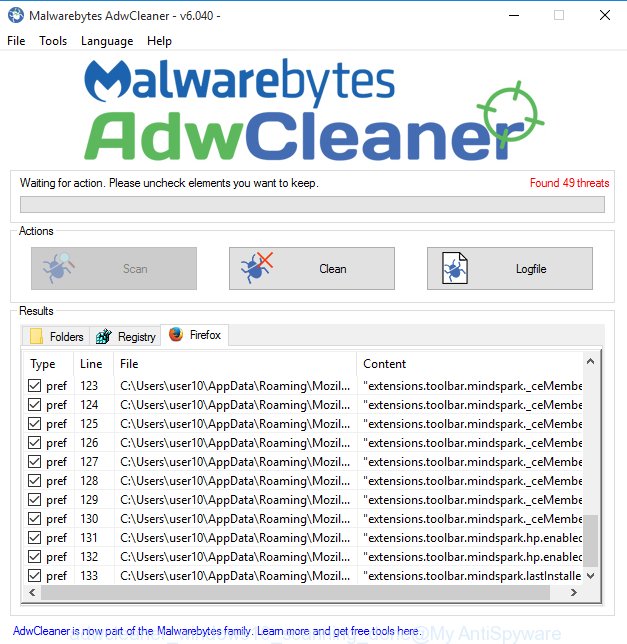
Review the report and then press “Clean” button. It will show a prompt as on the image below.

You need to click “OK”. Once the clean-up is finished, the AdwCleaner may ask you to restart your system. When your PC system is started, you will see an AdwCleaner log.
These steps are shown in detail in the following video guide.
How to stop Weather Forecast Alerts
It is important to run ad blocking software such as AdGuard to protect your computer from malicious pages. Most security experts says that it’s okay to stop ads. You should do so just to stay safe! And, of course, the AdGuard can to stop Weather Forecast Alerts and other annoying web-pages.
Installing the AdGuard ad-blocking program is simple. First you will need to download AdGuard by clicking on the following link.
26849 downloads
Version: 6.4
Author: © Adguard
Category: Security tools
Update: November 15, 2018
Once downloading is complete, double-click the downloaded file to launch it. The “Setup Wizard” window will show up on the computer screen as shown on the image below.

Follow the prompts. AdGuard will then be installed and an icon will be placed on your desktop. A window will show up asking you to confirm that you want to see a quick instructions as shown on the screen below.

Press “Skip” button to close the window and use the default settings, or press “Get Started” to see an quick instructions which will assist you get to know AdGuard better.
Each time, when you launch your PC system, AdGuard will launch automatically and block advertisements, pages such Weather Forecast Alerts, as well as other malicious or misleading pages. For an overview of all the features of the application, or to change its settings you can simply double-click on the AdGuard icon, that may be found on your desktop.
How does your system get infected with Weather Forecast Alerts browser hijacker
Most commonly, the Weather Forecast Alerts browser hijacker come along with the installation packages from a free hosting and file sharing web sites. So, install a freeware is a a good chance that you will find a bundled browser hijacker. If you don’t know how to avoid it, then use a simple trick. During the installation, select the Custom or Advanced installation option. Next, click ‘Decline’ button and clear all checkboxes on offers that ask you to install an unknown application. Moreover, please carefully read Term of use and User agreement before installing any software or otherwise you can end up with another unwanted application on your machine like this browser hijacker infection.
Finish words
Once you have finished the step-by-step guide above, your PC should be clean from browser hijacker, adware and malware. The Google Chrome, Firefox, MS Edge and Microsoft Internet Explorer will no longer show Weather Forecast Alerts unwanted startpage on startup. Unfortunately, if the few simple steps does not help you, then you have caught a new browser hijacker, and then the best way – ask for help in our Spyware/Malware removal forum.

















